
Want to Save This Article?
Enter your email & I’ll send it straight to your inbox. And you’ll get new recipes & tips each week.
There are so many amazing benefits to enjoying a real food lifestyle (AKA: getting back to great-great grandma’s food). While the benefits may be numerous, there’s always one big drawback to this lifestyle: dishes!
Dirty dishes, and lots of them, are just a way of life for a real food family. Sure, eating processed food means dirty dishes will accumulate in the sink, but usually this means just a few plates or a bowl (for that boxed cereal or toaster “pastry”). Enjoying “real food” means a family must stock basic ingredients and turn those ingredients into wholesome and delicious meals. This means bowls, skillets, knives, cutting boards, and whisks will be dirtied in the process.
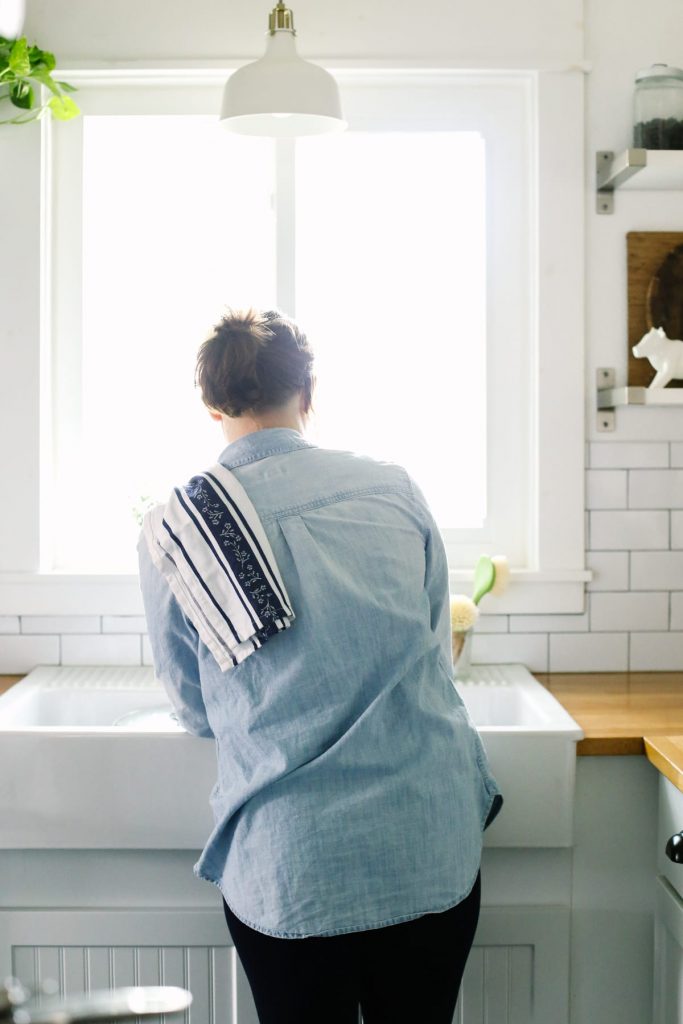
Here’s where natural living and real food merge together when it comes to tackling those dishes…
If enjoying real food means cooking and sometimes baking (PS: Did you make the blueberry muffins yet? Just one bowl is required.), a good grease-cutting, hard-working, nothing-left-behind dish soap is a major necessity. And this is where the dilemma begins…
Should I purchase the blue dish soap? It gets a D rating from the EWG.
Should I try out every “more natural” store-bought dish soap until I find one that gets the job done?
Should I try to make a do-it-yourself soap?
What about just castile soap? It seems to work on just about everything in my house.
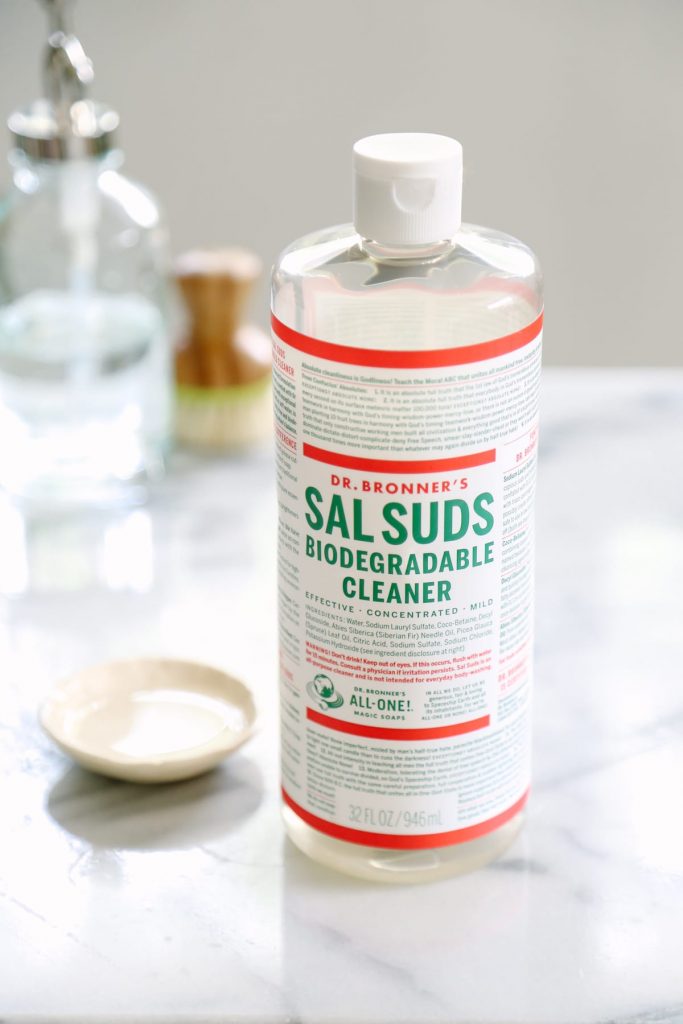
Friend, I’m not here to answer those questions for you. I hope to provide you with a little insight, through today’s recipe post, into what I’m currently using to clean my mountain-like pile of daily dishes.
The truth is, what’s best for you and your family is a decision that you need to make, whether this means sourcing a cleaner store-bought soap (check out the EWG for the best rated “cleaner” dish soap options) or making a do-it-yourself dish soap. But know this: There are effective dish soap alternatives to the low-graded (according to the EWG) dish soaps that sit in so many American homes, and a do-it-yourself soap is a great alternative option.
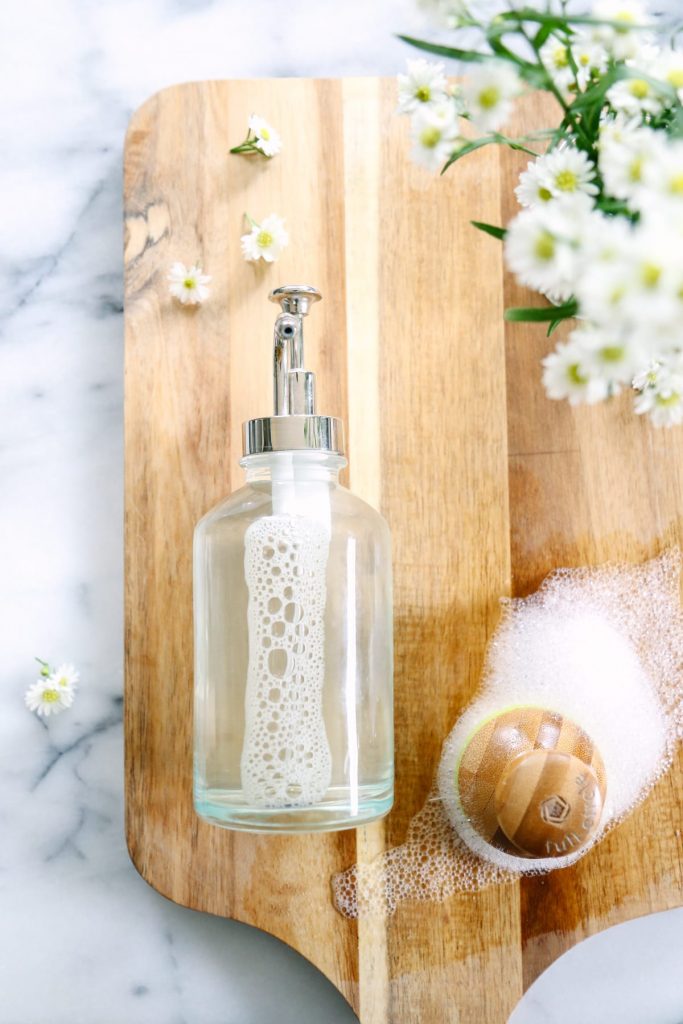
Last year I shared a dish soap recipe on the blog titled, Easy Dish Soap. That recipe truly is easy to make, but after months and months of making that soap, I decided there must be an even easier way to make dish soap, a super easy dish soap.
The key ingredient in my first dish soap recipe is Sal Suds, castile soap’s big and super strong brother. With that ingredient, I started to experiment with different combinations, and finally discovered just about the simplest dish soap formula that can be made at home. Simple and effective dish soap that takes less than one minute to make? Yes, please!!!
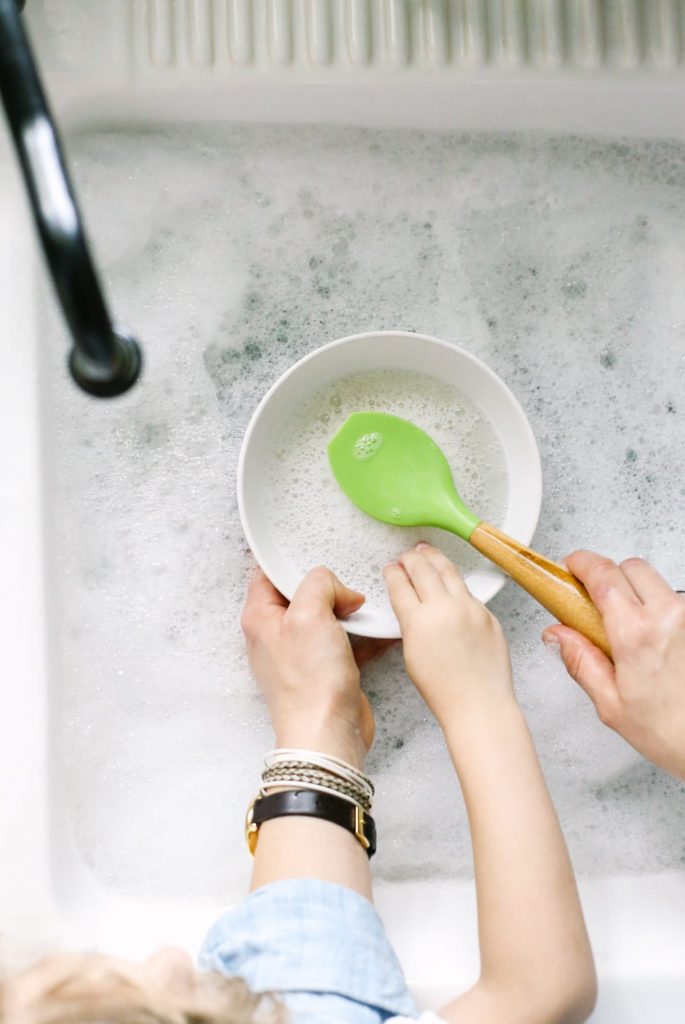
Let’s take a look at the 3 ingredients in this DIY dish soap…
Sal Suds: Sal Suds is Dr. Bronner’s tougher version of soap, although its chemical makeup makes it a detergent, not a soap (which is why it works so well to cut grease). Sal Suds is formulated to conquer tough cleaning projects, like sticky grease and stubborn dirt. Sal Suds is a hot topic in the natural community, so it remains a product that some people use and others stay away from. What’s all the fuss about? Sal Suds receives an A grade on the Environmental Working Group’s website. You can also read more about the big SLS debate on Lisa Bronner’s blog.
Sal Suds is highly concentrated, so it’s diluted in this recipe with water. You’re welcome to play around with a water to Sal Suds ratio that yields the best results for your dishes. I’ve found that a 1:1 ratio works best for me.
Castile soap doesn’t provide enough grease-cutting power to be considered an effective dish soap, in my opinion. If you’d like to try using castile soap in this recipe, then you’ll want to leave out the vinegar, but again, I don’t believe you’re going to get the grease-fighting power most people look for in a good dish soap.
Vinegar: Yep, good ol’ white vinegar. Unlike castile soap, Sal Suds may be combined with vinegar (another reason why Sal Suds is a great cleaning ingredient). We have really hard water, which means we deal with a lot of spotting on our dishes, even when we used the blue dish soap. I’ve found the vinegar in this recipe works like a rinse-aid to reduce some of the spotting that may occur from hard water. You’re welcome to leave this ingredient out of the recipe, but I personally prefer to add it.
Moisturizing Oil: This is another optional ingredient. Since this dish soap sits next to our sink, it’s also used as a hand soap on occasion, and particularly when Dustin’s been working in the garage (hello, dirty and greasy hands). I like to add a skin-loving oil to this soap to help take away the harsh soap feel since it’s being used on our bare hands. Water and oil don’t mix, so this oil rests on top of the dish soap until we shake the soap dispenser.
The color of your oil will change the color of your final product. If you use a deep yellow oil, like jojoba or olive oil, then your soap will have a slight yellow hue. If you use something like fractionated coconut oil, then your soap will remain clear. In the future, I’d like to play around with adding aloe vera gel (probably a couple of tablespoons) or vitamin E oil (probably a teaspoon) instead of the oil.
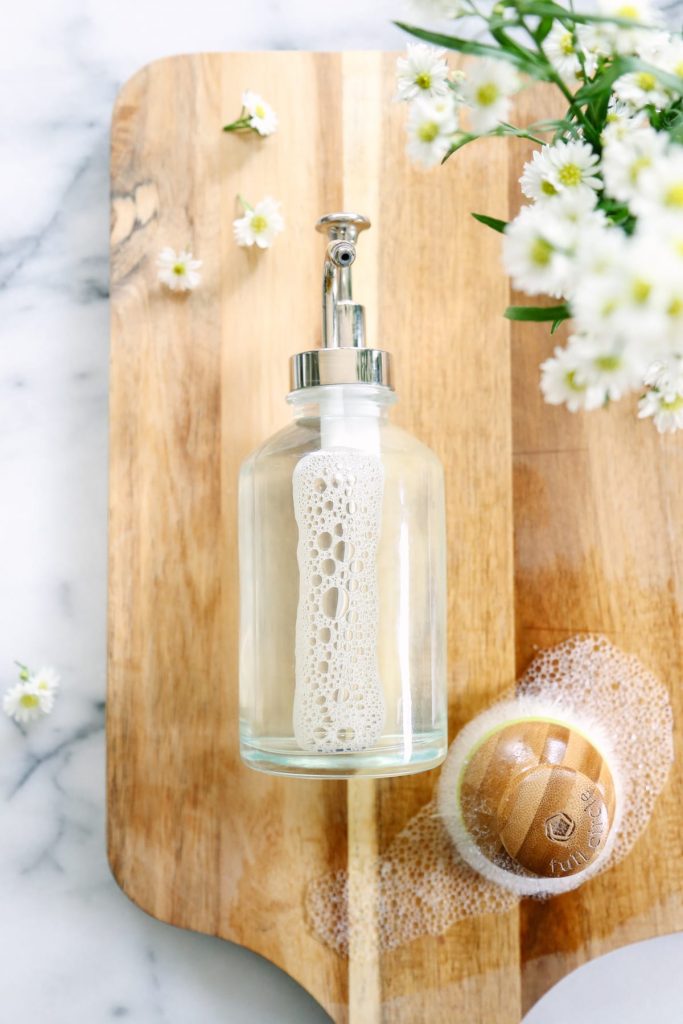
I may not be able to help you tackle that pile of glorious dishes (just think of the amazing food that you’ve made with those dishes!), but I can share my dish soap recipe to help you get those dishes squeaky clean.
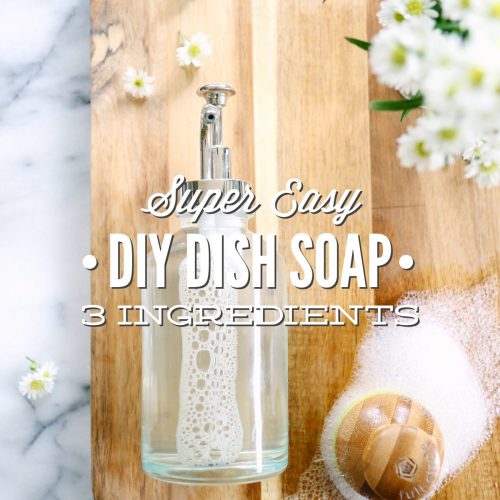
Super Easy DIY Dish Soap: 3 Ingredients
Equipment
- 1 8-ounce soap dispenser or 16-ounce soap dispenser
Ingredients
- 1/2 cup distilled water
- 1 TB white distilled vinegar optional
- 1/2 cup Sal Suds This ingredient is also available at most health food stores.
- 1 TB jojoba oil or other moisturizing oil: sweet almond, fractionated coconut oil, or olive oil, optional
Special Equipment:
Instructions
- Pour the water and vinegar (if using) into a soap dispenser (like this).
- Shake the bottle to combine the ingredients. Add the Sal Suds and oil (if using), and gently shake the bottle again to combine the ingredients. There may be bubbles at the top of the dish soap after shaking the bottle. This is completely normal.

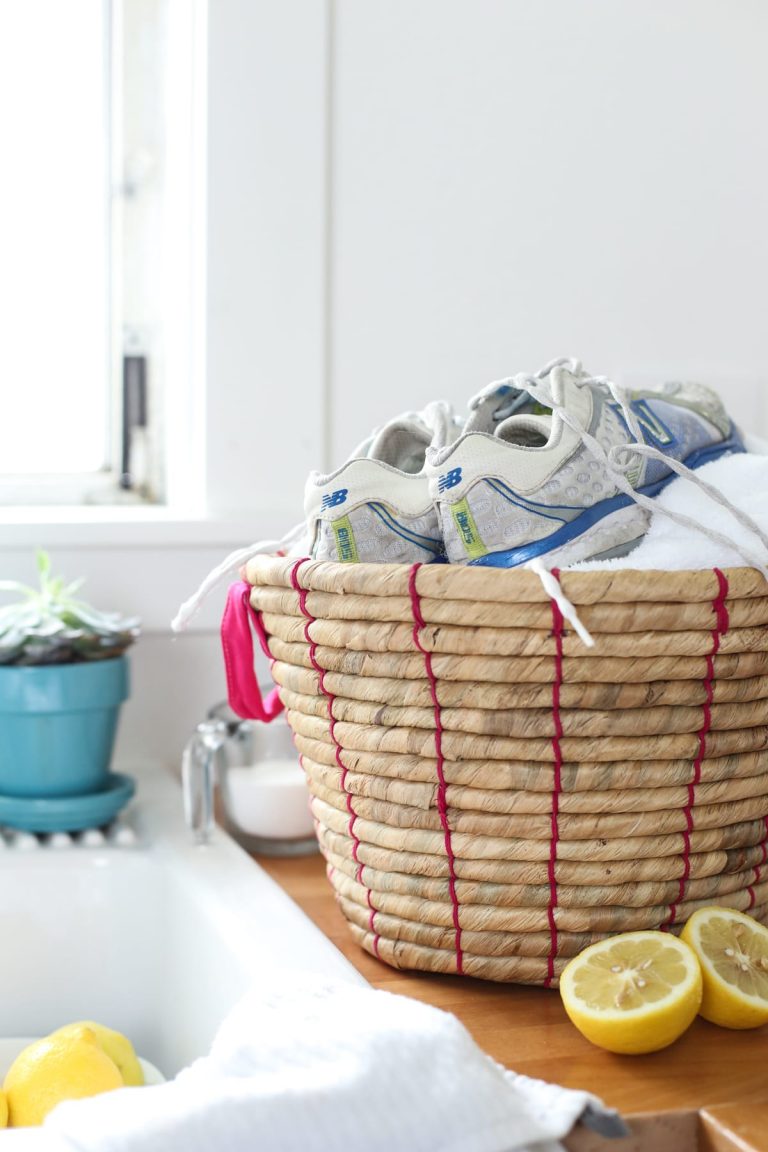
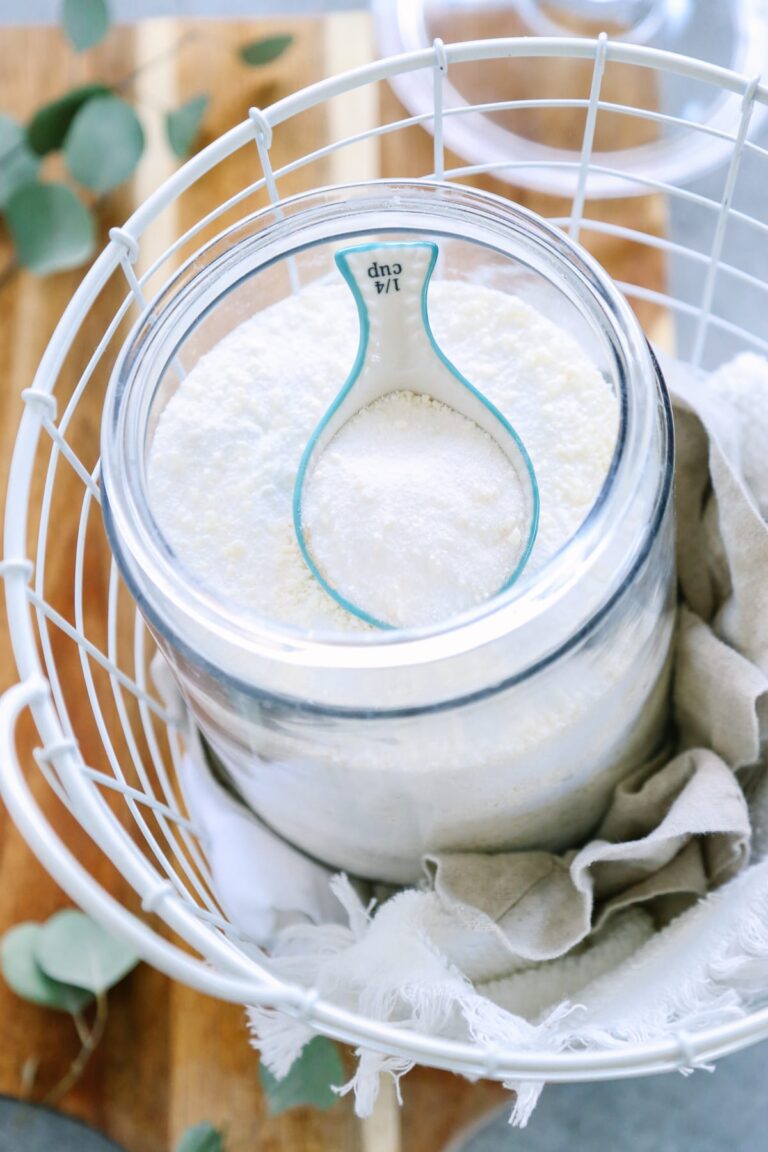
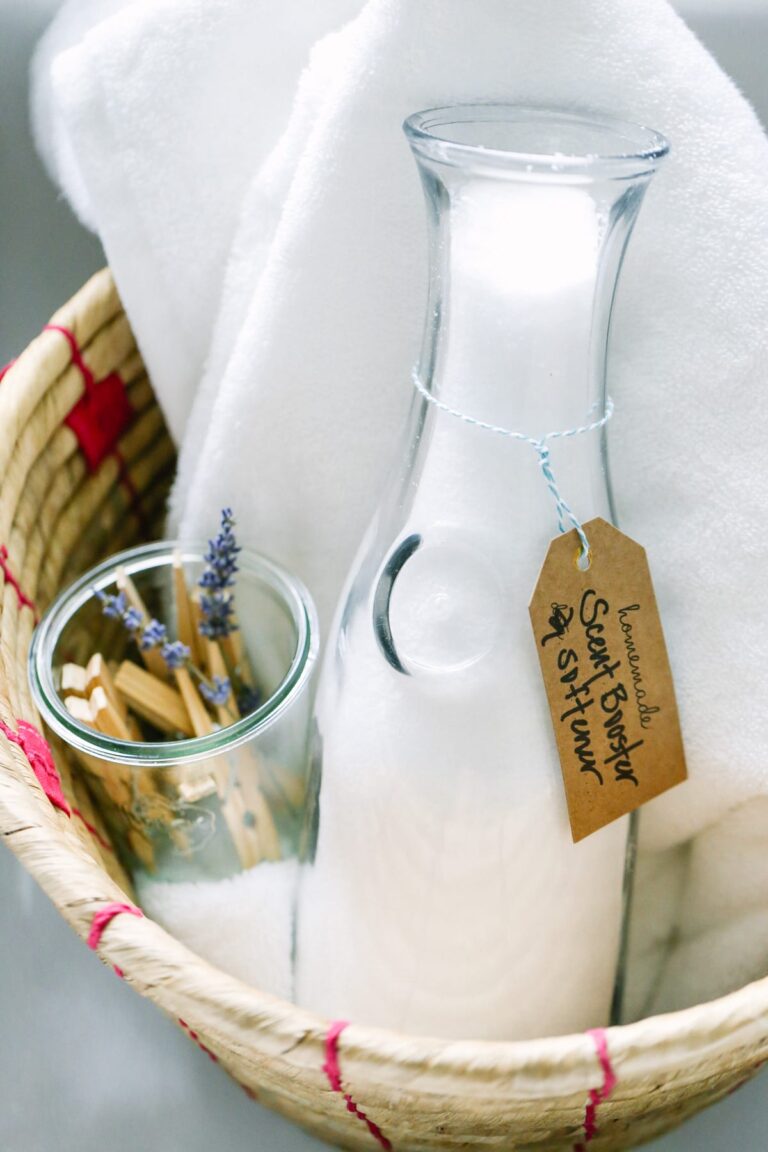

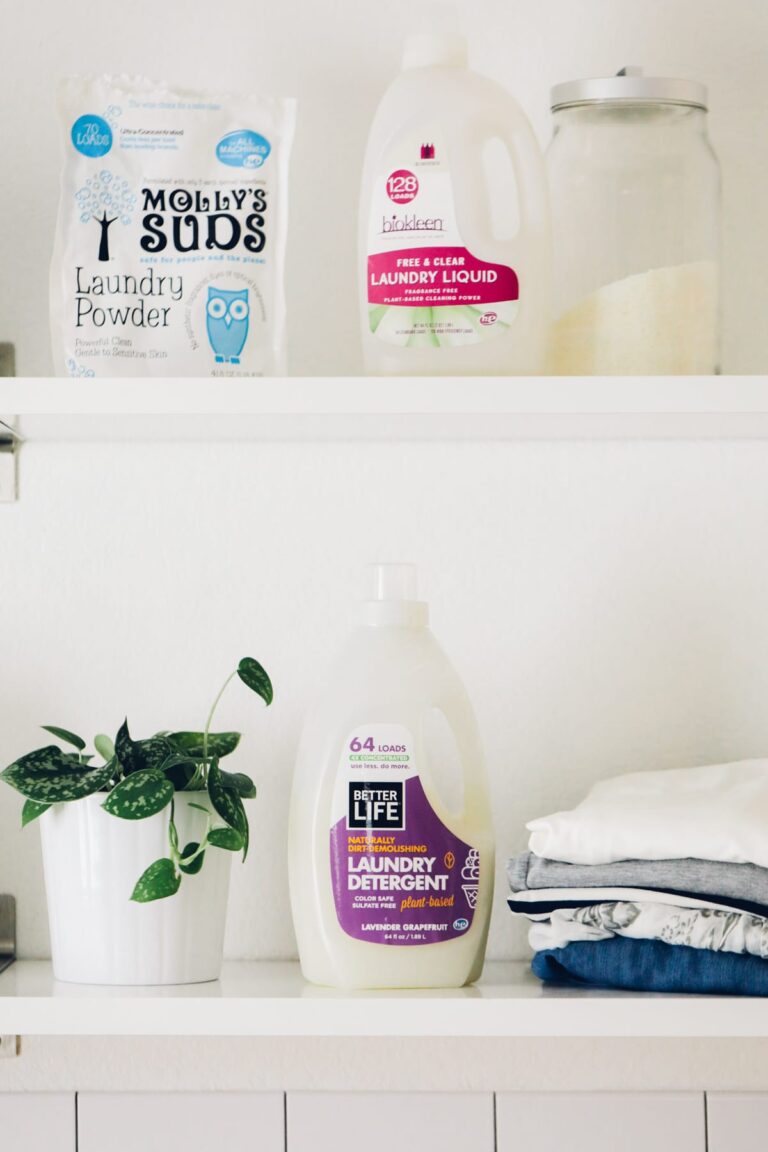
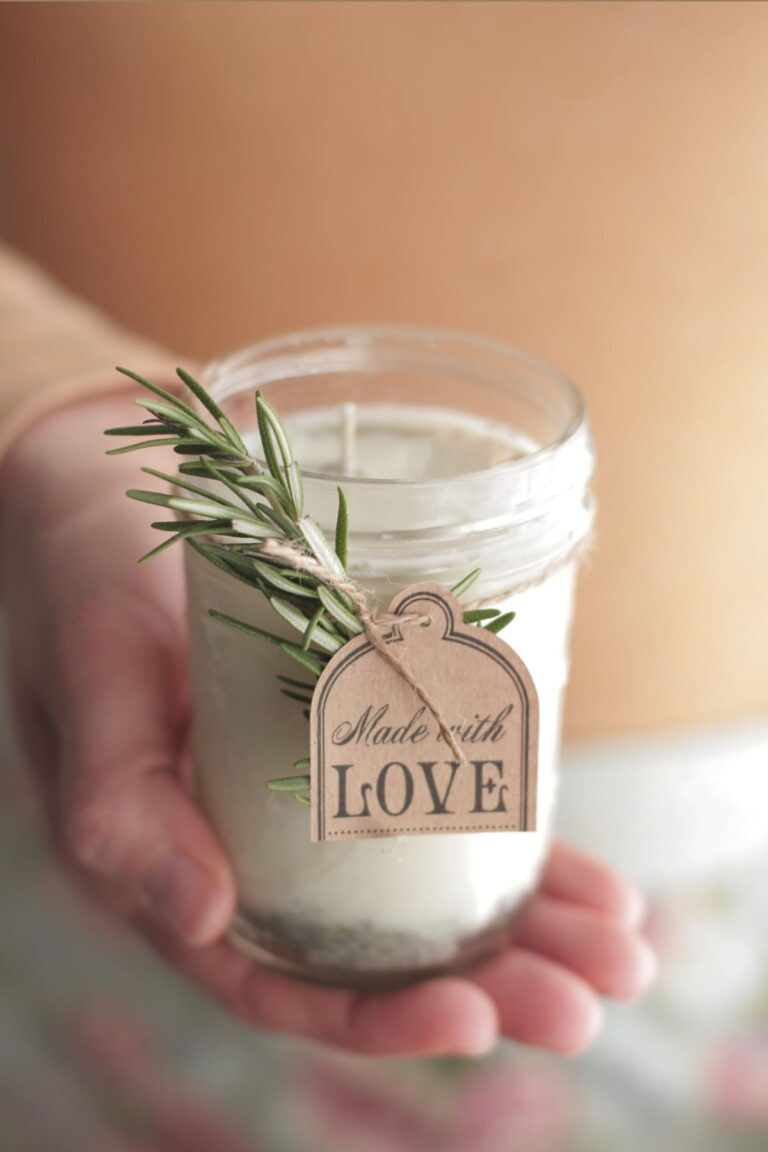
why is everyone so keen on using Dr Bronners anything? They use palm oil and supporting that is unconscionable.
Hey Michelle, Have you looked into the sourcing of their palm oil. Not all palm oil is sourced the same. Here’s a press release from 2018: https://www.drbronner.com/media-center/press-release/simple-swap-towards-sustainable-palm-oil/. It’s always important to look into sourcing and research further before just labeling something across the board as “bad.”
A great substitute for Sal Suds and does not contain SLS would be Soapnuts liquid made from soapnuts. You will not have the same sudsing power as with Sal Suds, but it is very very effective on grease. To make soapnuts liquid, use 4 soapnuts and 2 cups distilled water. Bring to a boil, lower heat and simmer for 2 or 3 hrs. Add additional liquid as it evaporates to keep it at about 2 cups liquid. Use in place of sal suds in the above recipe. Can still use the vinegar as it does not adversely affect the cleaning power.
Thanks for sharing, Chris. Also, looking into the differences in SLS and how it’s formulated is really fascinating and makes the fear associated with all forms of SLS not so scary.
Hi
I’m wondering what is the cost of this compared to store bought. I am trying to switch to all homemade soaps. What is joejoba oil and where do you buy it
Thank you
Gloria
Hey Gloria, The only real extra cost is the Sal Suds. That will depend on where you buy it. I suggest leaving out the oil, or going with olive oil to keep it budget-friendly. Jojoba oil is just another oil used in skincare. You can find it online or at health food stores.
Hi I was wondering if in the dish soap I would be able to put essinal oils in? Thanks and I really enjoyed this article. 🙂
Hey Kayla, You could!
second time making t his, and I’m hooked! It’s official! I’ve left the blue stuff behind! The only change I made to this recipe is changing out the oil for vitamin E and adding some orange essential oil! Wonderful! Thanks Kirsten!
Thank you so very much this is wonderful, will definitely try this and also try the homemade version of Castile soap.
Thank you, Kerri. Let me know how it homemade castile soap works out. You won’t want to use vinegar in this recipe if you use castile soap.
I just found your blog, and I am excited to try some of your cleaning recipes. I happen to have some Sal’s Suds in my cabinet, so I am going to try my hand at the dishwashing and laundry detergent recipes. I saw in the comments someone else has really hard water, so I hope these recipes work well for me too!
Hi, I made this dish soap according to the recipe and it is not waning my dishes at all! Grease and stains everywhere, help!
Hey Melodee, Hmmmm, I’m not sure why the grease and food isn’t being removed. Sal Suds is super tough stuff. Maybe try applying soap directly to a sponge and washing the dishes if they’re really greasy. How are you using the soap?
I am ALLERGIC to SLS, and can not seem to find anything at all to substitue the Sal Suds, to make my own dish soap….I have been searching, and come jup with nothing, or buying other peoples products, that don’t contain SLS, and it is expensive.
Hey Sharon, The best option, if you’re going homemade, is probably castile soap. It doesn’t work as well as Sal Suds, but I know people who like using it as a dish soap. Also, leave out the vinegar when using castile. Here’s my post about store-bought dish soaps, too: https://livesimply.me/2017/10/13/switching-products-natural-dish-dishwasher-soaps/. Maybe one of these options would be a good fit.
I have a homemade dish soap that adds salt to warm distilled water to dissolve and is said to increase the sudsing…wonder if that would be good addition if we don’t use sal suds but use castille soap instead. Thoughts??
You could. I don’t think the additional sudsing will help cut grease better though.
I love love LOVE this dish soap!! It’s simply and oh so effective! I also have hard water, super hard water and have found this soap cleans very very well! Thanks Kristin for all of your awesome recipes! And most importantly, for sharing!
Yay, Lori! I’m so glad you’re enjoying the soap!
Hi Kristin,
Love your blog! I’m in the process of starting to make several of your cleaners. I live abroad though, and can’t get Sal Suds where I am. Does regular castile soap work the same as a substitute?
Thanks!
Brooke
Hey Brooke, Thank you! Castile can’t be combined with vinegar and it doesn’t quite have the same power as Sal Suds when it comes to tackling grease. Other than that, castile soap can be used in any recipe as a sub for Sal Suds.
Hi,I was just wondering can i use this soap for baby bottles, is it safe?
Are the suds supposed to dissipate quickly. I am having lots of fun trying your other recipes. You do a great job coming up with the recipes. Keep up the good work!
Hey Jane, Yes, the suds will dissipate much faster than traditional dish soaps. You can use a bit more if this happens, or just use it without the suds. Thank you :).
Hi Kristin, thank you for your detailed post, sharing your thought processes and clear instructions.
I’m new to the world of homemade items, but open try. I’m glad I did! Managed to find the ingredients in Singapore :)) — works perfect!
I’ll go on to try other of your recipes when existing stock runs out. Please keep up your good work!
Quick question: I read that I could add essential oils, what would the measurements be?
Hi Kristin;
Just wondering about the Sodium Lauryl Sulfate in Dr. Bronners Sal Suds. According to Dr. Mercola, Sodium lauryl sulfate, is a surfactant, detergent and emulsifier used in thousands of cosmetic products, as well as in industrial cleaners.
It’s present in nearly all shampoos, scalp treatments, hair color and bleaching agents, toothpastes, body washes and cleansers, make-up foundations, liquid hand soaps, laundry detergents, and bath oils/bath salts.
The real problem with SLES/SLS is that the manufacturing process (ethoxylation) results in SLES/SLS being contaminated with 1,4 dioxane, a carcinogenic byproduct.
Is this not a problem then to use Sal Suds?
Hey Julia, Great question! This article from Lisa Bronner clarifies the confusion: http://www.lisabronner.com/there-is-no-cancer-risk-from-sls-sodium-lauryl-sulfate/.
Hi! I’m glad I found you because I’m enjoying your recipes for soaps and food!
Is there anything that you can add to the dish soap that will make it not as runny, like say, glycerin? I’m used to the more gel like soap.
Thanks!
Hey Linda, Welcome to Live Simply! I’m so glad you’re enjoying the recipes. GLycerin will probably make the soap a bit too runny. Unfortunately, I don’t really have a recommendation to make it more of a gel :(. You could use less water in the water.
I have not tried this yet but xanthan gum is a great thickner.
Xanthan gum is a plant-based thickening agent while guar gum is a thickener in cosmetic formulations. Add ½ teaspoon of xanthan gum to ¼ cup of room temperature distilled water. Then, use a mixer or use your hands to mix thoroughly for 5 minutes. It is important that you mix it thoroughly with the water or else it may clump up. We find giving the bottle a good shake will often do the trick.
Thanks, Shelly!
LS Team.
Hi,
Can you share where you got the glass pump your dish soap is in?
Thanks!!
Hey Joanne, This dispenser is from Target. I believe it came from the bath section in a two-pack.
Thanks for sharing all of your knowledge and research! Can essentials oils, like lemon or a protective blend, be added to the dish soap?
Hey Pat, Yes, an essential oil(s) would be a great addition!
I’m new to the “following”, but I have been reading your blog for the past month. I love love love your hand soap. I use Dr. Bonner’s Eucalyptus (had some left over) added Jojoba oil, tea tree oil, water, Vitamin E oil, Nag Champa essential oil (I have already have). It just fragrance the whole room. Your liquid laundry detergent…love it too! I use Sal Suds. Cleans better than store bought.
I was just thinking about making a dish soap. And, here I see you have one! I’m so stoke! Thanks Kristin!
Hey Natalie, It’s so great to “meet” you. I’m so glad you’re enjoying the blog and the recipes! The Eucalyptus Castile Soap sounds amazing; I’ll have to pick some up. Enjoy the dish soap :).
I cannot use SLS (terribly allergic after years of exposure). My skin cracks within minutes. Is there another degreasing alternative?
p.s. Thank you for assembling your knowledge for the rest of us!
Hey Laurie,
I think you could get a decent degreasing alternative from the Easy Dish Soap (https://livesimply.me/2015/04/04/easy-diy-dish-soap/), but add castile soap in place of the Sal Suds. The extra ingredients should help add a bit more power to the castile soap.
PS: I wonder if Sal Suds would create the same reaction, since it’s a bit different than the SLS in many commercial products.